
The Rise of Postal Voting: Convenience and Potential Pitfalls
Amidst the hustle and bustle of election campaigns, where candidates and parties strive to secure votes on doorsteps, there’s a growing trend that’s reshaping the electoral landscape: postal voting. This increasingly popular method of casting ballots has significantly impacted the dynamics of elections, particularly in recent years.
The Shift Towards Postal Voting
In 2021, nearly half of all voters in Germany opted for postal voting, bypassing the traditional process of visiting polling stations. This marked a significant increase from previous elections, highlighting the growing preference for this convenient and accessible voting option.
Simplifying the Process
Postal voting offers a hassle-free experience for electors. Once they receive their election notification, they can apply for a postal ballot. In many municipalities, this can be done conveniently online. Election notifications are mailed to all individuals registered on the electoral roll by their respective municipalities.
Automatic registration applies to those who have been registered as residents in the relevant municipality with their primary residence for at least 42 days before the election. Individuals who are not registered on the electoral roll must apply no later than 21 days before the election.
Timeline and Procedures
The postal ballots are dispatched from the 30th of January onwards. This sets the beginning of the postal voting period, which typically runs from the 6th to the 10th of February.
The postal voting kit includes a ballot paper, a small envelope, a sworn declaration, and a larger colored envelope. The ballot paper should be filled out clearly and unambiguously, typically by marking the preferred choice with a cross. Invalid symbols, such as smileys or other non-traditional markings, are not accepted. However, a dot or tick is generally considered acceptable. The completed ballot paper is placed in the small envelope, which is then sealed. The sealed small envelope, along with the completed sworn declaration, is then placed in the larger colored envelope.
Return and Deadlines
Postal ballots must be received by the responsible authority no later than 18:00 on the 23rd of February. Deutsche Post guarantees timely delivery if postal ballots are deposited by the last collection on the 20th of February. Alternatively, the ballots can be directly submitted to the designated authority. Deutsche Post delivers all postal ballots free of charge.
Factors Driving the Rise
The share of postal voters has steadily increased since 1990. The abolition of the requirement for a valid reason for postal voting in 2008 played a significant role in this trend. In 2017, the proportion of postal voters stood at 28.6 percent, reaching a record high of 47.3 percent in 2021.
The COVID-19 pandemic played a pivotal role in this surge. "Corona has reinforced the desire not to go to polling stations," explains Roland Abold of Infratest dimap. However, Peter Matuschek of Forsa described 2021 as an "exceptional situation." The postal voting share has already declined in recent state elections.
Matuschek and Abold anticipate that the percentage of postal voters may decrease further in the 2025 Bundestag elections due to the shortened deadlines.
Constitutional Considerations
The German Federal Constitutional Court has ruled that postal voting is constitutional. However, it acknowledges that postal voting can potentially undermine the electoral principles of freedom, secrecy, and publicity. In particular, it is difficult to rule out the possibility of voters being pressured or influenced in private settings.
Concerns and Challenges
Isolated instances of electoral fraud have also been reported, such as during the 2024 Saxon state election. A 44-year-old man was accused by the police of manipulating 151 postal ballots in favor of the "Free Saxons" party.
In the final weeks leading up to an election, parties often focus on swaying undecided voters. "When a large proportion of votes have already been cast before election day, it becomes more difficult for parties to exert influence at short notice," explains Matuschek. A high postal voting share thus makes last-minute shifts in the campaign trajectory more challenging.
Conclusion
Postal voting has become an increasingly prevalent feature of German elections, offering convenience and accessibility to voters. While the 2021 surge may have been partially driven by the pandemic, the trend towards postal voting is likely to continue. However, concerns and challenges, such as potential coercion, fraud, and the impact on campaign strategies, highlight the importance of ensuring the integrity and fairness of the electoral process.
